












of operation for rescue, law enforcement and critical safety missions in the mountains.
BY CHRISTOPHER KOEBERL CHRIS@COTLN.ORG
State-of-the-art drone technology controlled by the eyes and touch of highly-trained operators within the Clear Creek County Sheri ’s department has forever changed the eld


It’s been about three years to the day when Deputy Sheri Bradley Stepter took his oath and started his post with the sheri ’s department.
When he did, he brought an idea for the department moving forward.
“When I got hired, I was like ‘Hey, I own a drone, I love drones. Is there a possibility to implement that here?’” Stepter said.

Initial skepticism about the program was eventually replaced with encouragement within the department, according to Stepter.
at’s when the drone program literally took o , Stepter said.
Now, the sheri ’s department has two licensed drone pilots, Stepter and Sgt. Nick Aab, who can control any one of the three drones the sheri ’s department owns and maintains.
e three aircraft are each


designated by size for speci c missions and each has its’ own nickname:
e largest, with capabilities to reach altitudes of up to 14,000 feet, is “ under Brick,” according to pilots.
e medium-sized craft “Sparrow” can look above and beyond what human rescue resources can see, thanks to thermal imagery. at kind of perspective would take hours to locate on foot, rescuers said.


Extractive
BY HANK LACEY NEWSLINE COLORADO
e Trump administration’s revised Department of the Interior strategic plan calls for expanded fossil fuel development across federal lands, while omitting any reference to public land sales rst raised in an earlier draft.
Required under a 1993 statute and in 2010 amendments to that law, the draft plan outlines high-level goals for the Interior’s management of 480 million acres of federal land, including approximately 24 million acres in Colorado. Language emphasizing a commitment to extraction is particularly stark. In a break from contemporary descriptions of the natural resources under federal management, the Trump administration declared in a proposed introduction to the plan that the department “is the U.S. balance sheet, and natural resources are the country’s assets.”
“ ese lands — rich in energy, minerals, biodiversity, and recreational value — are worth trillions of dollars to current and future generations,” the draft introduction continues.
Chris Winter, executive director of the University of Colorado Law School’s Getches-Wilkinson Center for Natural Resources, Energy, and the Environment, said the draft plan con rms what many in the environmental community have feared: a shift away from conservation in fa-










Clear Creek Courant (USPS 52610)
A legal newspaper of general circulation in Idaho Springs, Colorado, the Clear Creek Courant is published weekly on Thursday by The Colorado Trust for Local News, 1630 Miner St., Idaho Springs, CO 80452.
PERIODICAL POSTAGE PAID AT Idaho Springs.
POSTMASTER: Send address change to: Clear Creek Courant, 750 W. Hampden Ave., Suite 225, Englewood, CO 80110
Call first: 1630 Miner St., Idaho Springs, CO 80452
Mailing Address:
143 S. 2nd Pl., Brighton, CO 80601
Phone: 303-566-4100
Web: ClearCreekCourant.com
To subscribe call 303-566-4100 or Scan this QR Code

SCOTT TAYLOR Editor scott@cotln.org
CHRIS KOEBERL Community Editor chris@cotln.org
JOHN RENFROW Sports Editor john@cotln.org
SUZIE GLASSMAN Education Editor suzie@cotln.org
DONNA REARDON Marketing Consultant dreardon@coloradocommunitymedia.com
LINDSAY NICOLETTI Operations/ Circulation Manager lnicoletti@coloradocommunitymedia.com
BUSINESS INQUIRIES
For advertiser or vendor questions, please email our business department at accounting@ coloradocommunitymedia.com



Columnists & Guest Commentaries
Columnist opinions are not necessarily those of the Courant.
We welcome letters to the editor.
Please include your full name, address and the best number to reach you by telephone.
Email letters to scott@cotln.org
Deadline
Tues. for the following week’s paper.

Colorado Trust for Local News asks readers to make us aware of mistakes we may have made.
Email scott@cotln.org if you notice a possible error you would like us to take a look at.





BY CHRISTOPHER KOERBEL CHRIS@COTLN.ORG
Local hikers and bikers get good news as the Colorado Mountain Bike Association reopened 14 miles of Trek Trails at Virginia Canyon Mountain trails adjacent to the Argo Mill and Tunnel in Idaho Springs.
“We’re stoked to announce the hotly anticipated reopening of our latest trail system,” Association Executive Director Gary
Moore said. “Between the Mighty Argo construction and our trail work, there’s been a ton of activity happening in the area, with trail crews, volunteers, and contractors working daily. anks for your patience!”
e bike and hike trails are expected to double the ridable terrain, from the current 14 miles open to 28 miles when the vision is complete, according to Moore.
“Yeah, we’re super excited about the trail system itself, we’re
about half built-out,” Moore said, adding that 17 trails are now open to the public.
Skill levels for the mountain trails will be color-coded, much like ski runs, starting with a Blue course up to Double Black trails reserved for the expert riders.
e park covers 400 acres and is located just north of Idaho Springs, above the iconic Argo Mill. Its terrain is steep and rugged, providing great opportunities for challenging rides and hikes, according to COMBA’s website.
e re-opened trails are expected to draw thousands of bike enthusiasts; a consistent concern
for local residents has been the availability of parking for the inux of vehicles.
All parking options are still south of the creek, with Colorado Blvd. o ering up the best locations. Riverside Drive is now closed to vehicle tra c. For the most accurate and up-to-date parking map, check www.parkidahosprings.com.
For the next couple of weeks, riders will access the trails from the west side of the Argo property. Please be mindful that Argo tours may be occurring and be respectful of any other users in the area.
The highly anticipated store takes the place of former Family Dollar
BY CHRISTOPHER KOEBERL CHRIS@COTLN.ORG
e shelves and refrigerators are stocked with everything from milk to pots and pans at the recently opened Dollar General store in Georgetown.
Several Georgetown residents said the ease and convenience of having a store like it in town saves a lot of trips to the nearest full grocery store Safeway in Idaho Springs.
“Yeah, it was basically a Clear Creek reunion when this place reopened, it was really funny,” Jessica einsen of Georgetown said.
“Being able to literally walk over here saves me time and money. It’s a really good blessing to have it back.”
e store replaced a for-
mer Family Dollar in the same location at 1560 Argentine St., which closed its doors more than a year ago.
In a statement Dollar General said, “It plans to create new jobs in the Georgetown community as the store is expected to employ approximately six to 10 people, depending on the individual needs of the store.”
e Company also touted that it “...Provides employees with competitive wages, world-class and awardwinning training and development programs and bene ts including day-one telemedicine eligibility as well as health insurance coverage options, 401K savings and retirement plans.”



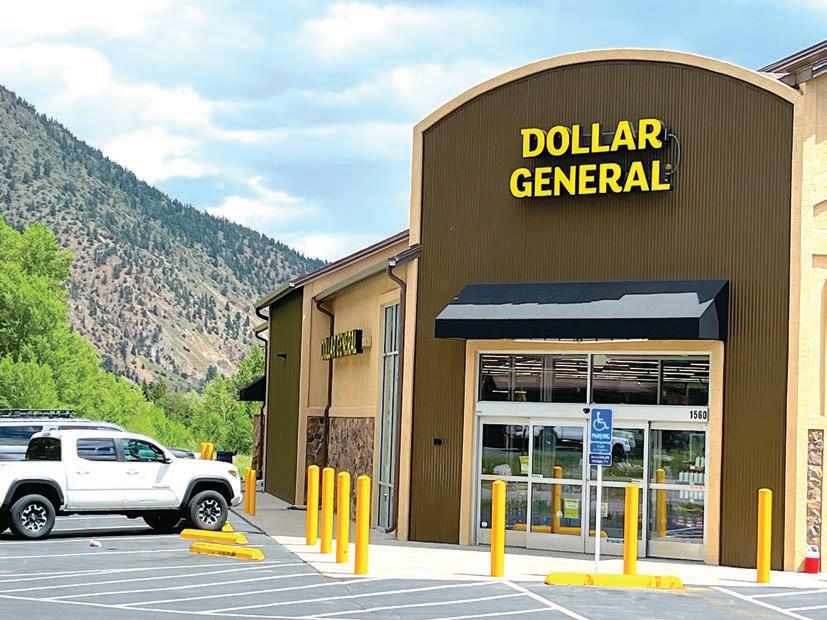
“I’m really excited to have it back,” einsen said.
This is the third installment of a monthly series about one of the hottest topics in real estate: Accessory Dwelling Units. ADUs have gotten a lot of attention recently as a housing option. You can read the previous installments online at my blog, http://realestatetoday.substack.com
My thanks to John Phillips of Verdant Living for helping with the research on this series of articles.
home improvement loan. It will probably be one of the largest loans the borrower has, exceeded only by the mortgage on their primary residence.
Talk About ADUs
ADUs — detached accessory (or additional) dwelling units, also called mini homes — are a wonderful idea for the right homeowner. They use an existing piece of residential real estate and create a separate living space. They are often used for intergenerational housing (aging parents, 20-somethings just starting out, etc.) and have long term value as rental property and add to the value of your real estate.
whatever) or with help from parents/ children/friends.
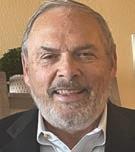

In my Real Estate Today column on February 20, 2025, which you can read on my blog referenced above, I discussed the basics of ADU finance. Today, I want to talk a bit more about the dynamics involved.
Financial issues are an impediment to getting an ADU built because of two general issues.
Have a friend or relative co-sign for the loan (a solution that could involve sharing ownership of the real estate).
Consider ways to show the lender the value of the ADU. A rental agreement with the tenant who will occupy the ADU, explain the ongoing rental value, or show how the ADU will increase the value of the real estate (thus increase the value of the mortgage security). Note, this sort of thing is just now being taken into account by the mortgage industry.
ADU and leave the primary mortgage in place; the result would be a “blended” interest rate that may be more palatable. In addition, there is an emotional issue, which may be present in buyers of moderate means. Taking on substantially more long-term debt can be intimidating. The “need” has to overcome the understandable reluctance.
So, you want to put an ADU on your property. How do you pay for it?
A couple of basics. First, an ADU is part of an existing piece of real estate (a primary residence). As a result, assuming money is borrowed to pay for it, the loan will be within the mortgage finance industry. Until recently, very few in that industry were knowledgeable about ADUs, much less about how they could be financed. Banks, other lending institutions, mortgage brokers, government finance authorities, didn’t understand how they fit in, but that is changing. Second, the amount of the loan will be relatively significant, far more than purchasing a nice automobile, or a
Credit Qualification. As anyone who has purchased a home knows, the mortgage industry has an extensive process to determine the credit worthiness of a borrower for a particular transaction (income, debt-toincome ratio, credit score, etc.). This is one of the reasons the majority of ADUs are built by relatively well off homeowners. For those of moderate means, financing the construction can be a challenge. This is unfortunate, because those are the homeowners who might benefit most having an ADU for intergenerational housing and, in the long term, creating rental income and building wealth by enhancing the value of their most valuable asset, their home. If a homeowner has a real need, and is determined to build the ADU, here are some practical suggestions that might improve credit worthiness:
Lower the amount of the loan and thus the monthly payment by increasing the down payment, using available cash (savings or
I recently learned about a fascinating program called TACT — Teaching the Autistic Community Trades. I was so inspired visiting their Denver facility that I must share it with you!
TACT is a pioneering and innovative nonprofit organization that provides hands-on vocational and technical training to young adults with Autism Spectrum Disorder (ASD). TACT aims to combat the historically high 90% under- and unemployment rate within this community by equipping individuals with practical skills that lead to sustainable careers. Through its immersive training programs, TACT is preparing young people with ASD — who now represent 1 in 36 children — for high-demand careers in the skilled trades. TACT offers a wide range of programs, including auto mechanics, computer coding, cybersecurity, carpentry, electrical work, electric vehicle conversions, 3D modeling, welding, and culinary arts.
As a “specialized day school,” TACT also bridges the gap between secondary and postsecondary education, creating clear pathways to employment. Its programs empower students to become more independent and earn a living wage in high-skill, high-wage occupations. TACT remains the first and only trade program in the country designed specifically for individuals with ASD, and it has positively impacted thousands of individuals and families throughout Colorado.
TACT envisions a world where neurodiversity is not only accepted but celebrated, allowing individuals on the autism spectrum to fully contribute their talents and find personal fulfillment. With a mission to empower the entire spectrum of individuals with ASD through education and employment in the skilled trades, TACT continues to build on a strong foundation, fostering opportunities for success. I’ve posted an inspiring video at http://RealEstateToday.substack.com
In Colorado, legislation supporting ADU development (which takes affect this July) includes a provision (and some funding), tasking the Colorado Housing and Finance Authority (CFHA) with organizing a program that would help ADU purchasers of moderate means qualify for financing. That program should be announced soon.
Lower the cost of the ADU by choosing lower cost options, ranging from less expensive building materials to things like more affordable appliances.
Borrower reluctance. It should come as no surprise that interest rates play a major role. Homeowners can use the equity in their main residence (by refinancing their current mortgage) to build the ADU. However, if the primary mortgage carries a low interest rate, as most do these days, the borrower will not want to refinance at current rates.
A good alternative is to apply for a home equity line of credit (HELOC) to pay for the
Finally, there is the possibility of a third party (someone not living on the property) investing in the ADU, thus facilitating the financial piece. Under recent legislation the legal mechanisms to make it work would need to be developed. It is an interesting possibility and could overcome the financing obstacles, particularly for those of moderate means.
Although the dynamics are very different, a similar idea has been tried in South Africa to help ease the need for housing there. I have a link to a Bloomberg article about that project on my blog.
To help with these issues, Verdant Living has published a very useful buyers guide, BuyersGuideColoradoADUs.com, with advice on financing. Another good resource is the VerdantLiving.us, or contact John Phillips at 303-717-1962
I want to thank the following people in addition to John Phillips for their input: Jaxzann Riggs, The Mortgage Network; Kristen Stultz, Macro Financial; Charles Edington, LOANstar; Cindy Beier, Cindy’s Property Solutions.
Clickable links for each column can be found at www.JimSmithColumns.com
May 29, 2025 — Divorcing Couples With a Home Need a Realtor With Specialized Training
May 22, 2025 — Home Sharing Helps Single Seniors Deal With Finance and Loneliness, Allowing Them to Age in Place
April 24, 2025 — Lennar to Build 1,500 Geothermal Homes; My Review of the Mustang Mach E
April 17, 2025 — Redfin Report Highlights the Increasing Cost of Buying versus Renting a Home
April 10, 2025 — The Typical Wood-Frame, SiteBuilt Home So Common Since the ’90s May Soon Be a Thing of the Past
Mar. 27, 2025 — Here’s How Money Is Handled at a Real Estate Closing
Mar. 20, 2025 — Thinking of Using a Reverse Mortgage to Purchase a Home? Here’s Some Information
Mar. 13, 2025 — Will Colorado Be Able to Sustain Its ‘Green Agenda’ Under Pressure From Washington?
Pollutants Emitted When Cooking With Gas
Oct. 31, 2024 — Cooperative Living Presents an Attractive Alternative for Downsizing Seniors
Sept. 26, 2024 — Some Thoughts on Keeping Your Death From Becoming an Undue Burden on Your Heirs
Sept. 5, 2024 — What Knowledge and Skills Should You Expect Your Real Estate Agent to Have?
Aug. 8, 2024 — Seniors Over 70 Might Consider Downsizing Into a Rental, Not a Smaller Home
July 25, 2024 — Many Homeowners Don’t Understand Title Issues, Which Could Lead to Big Problems Later On
June 6, 2024 — Here Are Some Simple Steps to Take to Avoid Unpleasant Surprises After Closing
Mar. 21, 2024 — What’s Behind the Buzz About ‘Indoor Air Quality’ and ‘Sick Building Syndrome’?
Feb. 22, 2024 — Most Sellers Don’t Know How to Interview a Listing Agent. Here’s Some Guidance.


$1,195,000



Here’s why. The fully equipped 511-sq.-ft. heated workshop shown here is included in the 3,500-sq.-ft. custom-built home at 2069 Garrison St. in Lakewood. Every possible power and hand tool a carpenter might want is in this workshop. The rest of this 3-bedroom/3-bath house is amazing, too, starting with the great kitchen, which has a built-in Miele espresso machine (my favorite!) plus a Sub-Zero refrigerator with cherrywood doors to match the kitchen cabinetry. The seller-owned 17-kW solar photovoltaic system meets all the electrical needs of the home, including charging the seller’s electric car. See all these features and more in the 11-minute video tour I posted at www.GRElistings.com. The website contains more photos and full descriptions of each room. Sorry, there will be no open houses. Call your agent or me at 303-525-1851 to see it in person.
Mar. 6, 2025 — 62% of Americans Think a 20% Down Payment Is Required, But It’s the #1 Myth
Feb. 27, 2025 — As Society Deals With Homelessness and Affordability, Expect a Greater Focus on Manufactured Homes
Feb. 20, 2025 — We Have a Tool to Help You Find the ‘Perfect’ Home That’s Not on the MLS
Dec. 26, 2024 — As Pro-Tenant Laws Expand, Some Small Landlords Are Considering Cashing Out
Dec. 19, 2024 — What Are the Costs of Buying or Selling a Home in Colorado?
Nov. 7, 2024 — We Need to Take Seriously the

Dec. 21, 2023 — D.R. Horton Inks Deal to Build Homes With OSB Made From Grass Instead of Wood
Nov. 23, 2023 — Scamming Has Become Its Own Industry, and We’re All Prospective Victims
Sept. 28, 2023 — Insurance Companies Are Pulling Out of California. Is That in Our Future?
Aug. 10, 2023 — What Are Some Common Mistakes That Homeowners Make When Selling?
June 15, 2023 — Don’t Let Capital Gains Tax Deter You From Cashing Out on an Investment Property
May 11, 2023 — Do Agents Inflate the Cost of Buying or Selling Your Home with ‘Junk Fees’?
Next month: Why smaller living spaces work well Congratulations to David Dlugasch,





Mines confirms Geer no longer employed at the university
BY CORINNE WESTEMAN CORINNE@COTLN.ORG
e Wheat Ridge man charged with killing Golden Police O cer Evan Dunn in a Nov. 6 crash is set to enter a plea on Aug. 4.
Stephen Geer, 43, has been charged with vehicular homicide and vehicular assault after he reportedly drove into the scene of a tra c accident along Highway 58, striking four people.
Dunn, 33, died at the scene.




GPD O cer Bethany Grusing was transported to the hospital with serious injuries, but city o cials con rmed she has returned to work and has been recovering in the months since the incident.
Two civilians were also injured, according to police reports.
Geer appeared in person at a June 23 hearing, as he’s been out of custody on a $250,000 cash/surety bond since November.
He was listed on the Mines website as a teaching assistant professor in mechanical engineering at the time of the incident. is was still the case as of his most recent court appearance in mid-May.
However, by June 23, Mines spokesperson Erich Kirshner con rmed Geer was no longer employed at the university.
Geer is no longer listed on the Mechanical Engineering Department’s faculty and sta page, as he had been during the 2024-25 academic year, but he is still listed in the Directory of the School. Kirshner said Mines was still updating its website for the 2025-26 academic year.
Since waiving his right to a preliminary hearing in March, Geer has been scheduled for arraignment twice, which is when he would enter a plea. However, both times, his arraignment was continued — once from April 28 and now from June 23.
On April 28, the prosecutor and defense attorney asked the judge for more time to negotiate.
On June 23, based on their comments to Judge Russell Klein, both sides wanted to ensure there was plenty of time to consult the victims in the case. ey asked Klein to reschedule Geer’s arraignment for July or August, preferably in the late afternoon to ensure interested parties could attend the hearing.
“ e court is very aware of the nature of this case and its complexity,” the prosecutor said.
Klein granted it and rescheduled Geer’s arraignment for 3:30 p.m. Aug. 4 at the Je erson County Courthouse.
Nov. 6 incident
According to the arrest a davit led against Geer, at 4:38 p.m. Nov. 6, Golden police o cers responded to eastbound Highway 58 just east of Washington Avenue. ey were investigating a crash between a Toyota Tacoma and a Subaru Crosstrek.
Amid slick and snowy conditions, the Toyota had reportedly lost control while the Subaru was trying to pass, hitting it. Both vehicles were disabled near the median.
All involved vehicles were on the far-left side of Highway 58, according to the afdavit, with a Golden Police vehicle po-

sitioned behind the other two. All other tra c was moving to the right, away from the original crash scene.
e Subaru’s driver, the Toyota’s driver and her father, Dunn and Grusing were outside the vehicles getting photos and evaluating the scene at 4:53 p.m. when a black Mazda traveling eastbound entered the area.
e Mazda reportedly hit the Toyota and then the Subaru, pinning Dunn under the latter. He died from his injuries at the scene.
According to the a davit, Grusing and the Toyota’s driver also sustained serious injuries, with the latter su ering a skull fracture and brain bleed. Her father, who was thrown over the jersey barrier, also sustained a large laceration to his head and elbow, the a davit describes.
e Subaru driver was uninjured. A third GPD o cer who was in the patrol vehicle behind the initial accident scene was also uninjured.
Shortly after the crash, authorities identi ed Geer as the Mazda’s driver. He reportedly told state troopers at the scene he’d been driving home after having a beer at a local bar with a coworker. He told troopers he’d noticed “yellow ashing lights and attempted to stop” but wasn’t able to, the a davit describes.
Investigators detected alcohol on Geer’s breath, the a davit continues, and he initially agreed to voluntary roadside sobriety tests. However, after he was informed of his Miranda rights around 6:06 p.m., he refused to talk further or complete the sobriety tests.
After receiving a search warrant, investigating troopers completed a blood draw at 8:46 p.m. at the Je co jail, the a davit continues.
It also states that Geer has no previous criminal history.
On Nov. 14, the District Attorney’s Ofce formally charged Geer with One count of vehicular homicide, a class 3 felony, for Dunn’s death; Two counts of vehicular assault, a class 4 felony, for injuring Grusing and the Toyota’s driver; One count of third-degree assault, a misdemeanor, for injuring the Toyota’s driver’s father; One count of driving under the in uence, a misdemeanor.
City o cials have con rmed Dunn is the rst Golden police o cer to be killed in the line of duty.
Over the last several months, Goldenites and others across the country have honored Dunn’s memory by fundraising for his family and Grusing’s recovery. e community also honored Dunn with temporary and permanent memorials, including adding his name to the Colorado Law Enforcement Memorial at Camp George West and
a stretch of Highway 58 in his memory.
vor of extractive industries.
“ e administration is going to emphasize extractive industries and fossil fuels on federal public lands and is going to move away from conservation and renewable energy,” he said.
e plan makes no mention of renewable energy or even of climate change, a sharp contrast from Interior’s current guiding template. e Bidenera2022–2026 strategic planemphasized climate resilience and a transition to clean energy. e new draft, by contrast, omits the subject of climate entirely. at is one of several breakpoints critics say reects a reversal in federal priorities.
e absence of any mention of renewable energy in the strategic plan signals, to some experts, a deeper shift in federal priorities. Wyatt Sassman, an associate professor at the University of Denver’s Sturm College of Law who specializes in natural resources matters, thinks a federal abandonment of that imperative is already underway.
“At least some reporting has suggested that (the) Fish and Wildlife (Service) has stopped issuing permits for wind energy projects,” he said. “I don’t see any legal process for that. And it’s seemingly inconsistent with the way it’s treating fossil energy projects.”
It may undercut environmental review
President Donald Trump did not wait very long after taking o ce to tighten restrictions even on wind energy production that does not rely on public lands for facilities. Seventeen states, including Colorado, and the District of Columbia launchedlitigationMay 5 in a Bostonbased federal court in an attempt to prevent the administration from executing his Jan. 20 executive orderthat purports to halt o shore wind energy development.
Trump’s team at Interior is expected to pursue a continued sharp reversal, facilitated by a likely attempt to deregulate oil and gas activities on Bureau of Land Management and other lands and waters under Interior’s control. Authors of the document explain that the department “will focus on expediting leases and streamlining and cutting regulations while promoting conservation.” Moreover, “by o ering
economic incentives and better access to energy resources, Interior will encourage private investment and create more American jobs.”
Environmental advocates say they are not surprised by the draft plan’s focus on stimulating the national economy, but they warn that the plan may presage a determined e ort to evade or undercut processes mandated in public land laws. e danger in that approach, Sassman said, is that Interior decision-makers may act in a manner that is blind to environmental consequences. “My sense is that it will get in the way of them trying to make good, well-reasoned decisions,” he said.
Sally Paez, a sta attorney at Santa Fe-based New Mexico Wild, warned that Interior’s language about process streamlining signals an intent to sidestep longstanding environmental review laws.
“ e thing that really concerns me is that what I’m seeing is a lot of e orts to sort of cut any type of public participation, to cut any type of perceived red tape,” she said. “And, by ‘perceived red tape,’ what I mean are bedrock environmental laws that are in place to make sure that extraction is done in a way that doesn’t destroy our very limited water supplies in our arid state, and doesn’t impact big game corridors or endangered species and things like that.”
Environmental advocates warned that Interior’s approach may undercut review even under the 1969 National Environmental Policy Act. Paez called the e ort “unprecedented,” citing fast-tracked reviews and diminished public comment periods.
e administration did not provide in the newest version of the draft strategic plan any details about how much additional logging Interior will seek to advance on BLM lands.
A March executive order directs increased logging on BLM and Forest Service lands, and the strategic plan calls for “active timber management” to reduce wild re risk but does not specify locations at which more timber extraction would occur or the scale of tree removal.
Grazing and mining are not speci cally addressed in the May document, though the drafters note a commitment to “clean coal” and reiterate a traditional adherence to “multiple-use land management.”
According to the draft plan, that approach will “ensure the country’s public lands can be used for recreation, grazing, tim-
ber sales, mining, and mineral exploration, all of which provide revenue for the U.S. government.”
Public land sales dropped
Beyond extractive industries, the strategic plan outlines priorities for water infrastructure but avoids mention of critical regional shortages. Interior would “upgrade and maintain water infrastructure to ensure water supplies while also promoting water conservation and reuse for drought resiliency.” But there is no mention in the document of how the department would approach questions of reduced supplies in the Colorado River Basin and California rivers and, other than a nod toward hydropower as an energy source, the challenge of assuring adequate ows for wild salmon in the Columbia River system and other anadromous sh freshwater habitats.
Interior o ers little detail about wildlife protection in the draft strategic plan, at least beyond mention of promoting hunting and shing on public lands and a promise “to remove harmful invasive species, delist endangered species once recovered, and involve local communities in decisions about managing nature and wildlife.”To Winter, this lack of clarity raises a risk that Interior may fail to advance the goals of the Endangered Species Act.
“We’ve already seen very aggressive steps to roll back protections under the Endangered Species Act,” he said, pointing to a recent proposal to rede ne the ESA’s de nition of harm to exclude damage to vital habitats. “We suspect that the administration intends to undermine protections for wildlife moving forward.”
e draft strategic plan includes a stated goal of strengthening “governmentto-government relationships with Native Americans and Insular Areas.” at objective, the document says, would involve “shared management of land, increasing investment in education and jobs programs, and managing trust assets for bene ciaries.”
However, the plan does not mention existing co-stewardship arrangements at major national monuments in the West, such as Bears Ears in Utah and Chuckwalla and Sáttítla Highlands in California. It also does not address whether those monuments will retain their protections under the Antiquities Act. e draft strategic plan’s utilitarian perspective may nevertheless have little


impact on expected legal battles over the department’s e orts during the next few years to facilitate oil, gas, and coal production and mineral exploration, logging, and grazing.
“I’ve never seen the strategic plans relied on in a legal context,” Sassman said. “ ere are other kinds of legal actions they will have to take in order to e ectuate these goals.”
A rst e ort at a 2026-2030 plan, released in April, also declared that Interior’s rst priority will be to “restore American prosperity.” at version, unlike the one Interior released last month, also explicitly raised the prospect of public land sales. Winter said that the exclusion of that idea from the new rendering should not be taken as a signal that the administration has abandoned the proposition.
“I don’t think the administration is backing away from that idea,” he said. “ is issue is being taken up by Congress as part of the (budget) reconciliation process and this is really an issue that will be determined by Congress and not by the department because that’s where the authority lies.”
e public will have an opportunity to comment on the plan, once Interior nalizes a draft. e department has not yet posted it at regulations.gov, the federal government’s online portal for that purpose. is story is from Colorado Newsline. Used by permission. For more, and to support the news organization, visit coloradonewsline.com.






“It really takes down that time, that critical time trying to gure out if someone is injured, possibly on their last breath, we’re able to nd them a lot faster,” Stepter said. e smallest drone, “Fire y,” can land on a piece of paper but is able to maneuver in ways that boggle the mind.
Fire y, with the operators’ command, can y inside a house or structure, room by room.
“Precision controlling, we have a set

of goggles that allows you to view in real time where the drone is and what it’s seeing. en a motion controller gives me millimeter precision that I’m able to navigate going through a doorway, under tables, under chairs, over dressers, whatever have you,” Stepter said.
Training and obtaining licensing as a drone pilot at this level requires approval by the Federal Aviation Administration.
A “Part 107 FAA Certi cation” exam must be passed for a pilot to earn a license to y.
Stepter said, with his training and homework, he was able to pass the exam on the rst attempt.

However, “It’s a pretty tough test,” he said.
Special exemptions for ight area, height and maneuvering are a orded to law enforcement – as long as the pilots have maintained all of their FAA drone certi cations.
Perhaps the most signi cant advantage to a drone resource, both pilots Stepter and Aab said, is the opportunity to put technology in the place of what would otherwise require a human resource.
“We’re able to assist the SWAT team, we can actually y it into buildings in front of SWAT team members and it can clear rooms faster than sending someone in.

I’d rather send in a piece of technology as opposed to someone who could get hurt,” Aab said.
Simply for the fun of it, or to gain hours and experience as a pilot, Stepter had another idea to get the community interactively involved in the sheri ’s drone program. Look for it on Facebook. It’s a weekly challenge posted on Mondays for locals to locate “Where the Drone was Flown”. Random photos and videos will be posted, with the winners identifying the location of the shot earning a CCSO Challenge Coin.








Ilove Paul Simon’s 1968 hit, “America.” It captures the soul of a wandering, wondering young man in search of his identity and the role he’s to play now that he’s an adult.
After she’s dozed o , he con des to his friend Cathy that he’s lost. I identify with that state of mind. At eighteen, I too was lost, and now in my ripened age, at times it feels as if I’ve come full circle.
I sometimes wonder if this is still the land I came of age in, the one Jay and the Americans rhapsodized about in their 1966 pop hit, “Only in America.” My deep love for America says yes, that it’s only a matter of her temporarily losing her way. But I also admit to an occasional foreboding, troubled that she’s changing and the America of my lifetime is morphing into something I cannot put my nger on. And if that were the case, I wouldn’t like what I’d discover.
In his song, Paul has a limited view of America. He’s hitchhiked from Saginaw to meet Cathy in Pittsburgh where they hop a bus and head eastward across Pennsylvania to the New Jersey Turnpike. at was the part I found disconcerting. I felt they were heading in the wrong direction. From my earliest days, I sensed
JERRY FABYANIC

In August 1953, Pete Schoening and his teammates faced a di cult time. ey were attempting to climb K2, the second-tallest mountain in the world. e group was above 25,000 feet, at what they called Camp VII, when signi cant snowstorms hit. For seven days, the men hunkered down waiting out the weather. When the storms subsided for a short time, Alex Gilkey, a member of the tight-knit crew, got out of his tent to assess the situation. As he exited the tent, he collapsed. ey discovered that he had blood clots in his leg, and every minute above 25,000 feet created a growing likelihood that the clot could leave his leg and kill him by lodging in his lung or brain.
Knowing his life-threatening condition, the team immediately made plans to get him o the mountain. e weather did not support leaving their location at Camp VII because the storm had picked up again. e team did not care; they needed to get their friend o the mountain. So, they created a makeshift stretcher and began to take Alex to a safer altitude.
For safety’s sake, on the journey down, each group member was tied to the next. After great di culty, the team was within 150 vertical feet of the camp they were trying to reach when the lead climber slipped on an icy patch. His fall was so sudden that he pulled the climber tied to him o his feet and into a free fall. ree more climbers and the makeshift stretcher were all caught up in the sudden event



west was the way to go. Regardless, Paul gets at a strain in the American psyche: the urge to pick up and go and to explore new terrain. We’re a nomadic people even if it’s only in our daydreams. Packing up and heading to a new place causes con icting emotions to rise within a wayfarer. On the one hand, there’s the thrill and excitement about the adventure, discovering what’s out there and testing your mettle rst in surviving then thriving in your new land.
On the other hand, you realize you’re leaving all you’ve known and intuitively sense, even if you haven’t read Tom Wolfe’s “You Can’t Go Home Again,” that you’ll never be able to return. Oh, you certainly could go back to visit and reminisce, but the life you leave will invariably change in ways that you won’t be part of as you will in ways alien to your kith and kin. In a sense, you’ll become a stranger in the land of your birth.
I wonder how my grandparents might’ve felt after leaving their rural na-
tive lands in Eastern Europe and being thrust into the blast furnaces of Braddock, Pennsylvania and the factories in nearby towns where they scratched out a living under sub-human conditions. Did they yearn to return to Europe? Did they rue the choice they made? Or did they simply steel up and did what they could do so they could endow their children with the opportunity for a better life than what they would’ve had in the Old Country. A form of self-sacri ce perhaps? I like to think it was the latter. Coming from those beaten-down, impoverished lands, they had already learned that life can be brutal. us, they likely neither regretted their decision to emigrate nor dwelled in a self-pitying, woe-is-me cesspool. Plus, they’d die knowing they put their children and grandchildren in a better place. And that place was and is America.
I will never give up on America when she gets o kilter. e reason is she remains far greater than the specs of what’s currently being played out. As I wrote before, America is an idea, a most fantastic one. It’s still the land of opportunity for those who choose hope over despair. It’s on the faces of the beaten-down who

each day pick themselves up and struggle onward to make a better life for themselves and their kith and kin. It’s on the faces of immigrants yearning to become part of America’s story. Despite the calumny raining down on them, they’re personi cations of what America is about.
In his rendition of “America,” Neil Diamond captures that sensibility. He wrote the lyrics in tribute to his grandparents who ed czarist Russia and, like my grandparents, found a new start in America. In an interview, Neil said his song was also about the “immigrant in all of us.”
anks to the courage and steeliness of their immigrant ancestors, most Americans have likely found their place in America. Interestingly, for many, most from what I can ascertain, it’s the place of or relatively close to the place of their birth.
For the rest who didn’t and don’t just daydream, it’s somewhere else in America, not only between Saginaw and New Jersey.
Jerry Fabyanic is the author of “Sisyphus Wins” and “Food for ought: Essays on Mind and Spirit.” He lives in Georgetown.

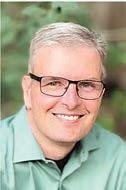
Jim Roome

and began falling as well. With only seconds to react, Pete Schoening was able to halt the free fall of the other six using an ice pick, a snow-covered boulder next to him and the rope that connected him to the other six. Although they were battered and bruised, Schoening saved everyone on the team. at heroic moment is now, in mountain climbing lore, called “ e Belay,” and Schoening’s ice pick is on display in the American Mountaineering Museum in Golden.
e Belay gives us some amazing ideas to consider when we need encouragement.
e rst thing that comes to mind, for me, is the incredible impact that friends have on our lives. Alex’s friends stopped everything they were trying to accomplish to save him. Good friends are a gift. ey are di erence makers, lifesavers, and they should be celebrated.
Equally as important, this story reminds us that the ripples of our actions can be far-reaching. His entire life, Schoening insisted that he was not a hero; he was simply doing what needed to be done in that moment. In 2006, all 28 of the children and grandchildren born to the families of the men Schoening saved gathered to celebrate his quick thinking. Every one of those 28 owes their
lives to Schoening. Imagine how large that number will be in 100 years. ink about how di erent the world would be without all those people.
Our actions might not keep someone from falling o a mountain, but the ripples of doing the right thing, of continuing to push forward amid di culty, cannot be underestimated. Your push, your determination, your example might be the driving force behind someone else’s success. Do not underestimate the power and in uence of the model that you provide each day.
ere are amazing stories all around us. Celebrate the power of your story. ings may not be easy, but you have got this. I hope my words encourage you and that you will share them with those who need support.
ank you to everyone who has shared their stories with me so far; I truly appreciate hearing about the valuable ideas you nd in these columns and how you use them to uplift those around you. You can reach me at jim. roome@gmail.com.
Jim Roome lives in Arvada with his wife, Beth. He spent 34 years in public education. Lessons learned from the one-two punch of being diagnosed with MS shortly before his best friend was diagnosed with terminal cancer led him into a new pursuit as a freelance writer and speaker. He uses his life experiences and love of stories to inspire, educate and encourage local, national and international audiences. Contact him at jim.roome@gmail.com.
This mountain was listed for sale — but not to you
Editor’s note: Senate Energy Chairman Mike Lee’s plan to sell o thousands of square miles of Western public lands has apparently been blocked for now due to Senate rules, but Lee has vowed to resurrect his idea of selling public lands to private interests.
To my fellow Coloradans, You may have heard that public lands are up for sale — but did you know they include our own backyard treasures? Gothic Mountain, the trails around Crested Butte, and parts of the Maroon Bells Wilderness could soon belong to billionaires or corporations, not to the people who love and rely on them. ese aren’t hypothetical risks — this was written into legislation that would allow buyers to sit on the land for any future use, including mining or development.
Prices aren’t going to be cheap and they certainly aren’t going to average Coloradans.
I’m a scientist and mom of three in Centennial. For over 20 years, I’ve conducted ecological research at the Rocky Mountain Biological Laboratory (RMBL), on Forest Service lands now at risk. Since 2018, I’ve tracked ground temperatures every ve minutes at 30 alpine sites to understand whether a species of Sulfur butter y caterpillars can nd microclimate refuges




to survive climate change. is work may sound obscure — but it’s part of a bigger picture. We can’t x what we don’t understand. Longterm, placebased science like this is how we learn what to protect and how.
RMBL has conducted ecological research since 1928 — approaching 100 years — and revealed why 20% less water reaches our rivers today despite normal snowpack — crucial knowledge for managing water for 40 million people across the West. RMBL scientists are also studying native bees which we barely understand — and may be crucial to rescue colony collapse and our food system, having already documented a 60% insect decline. ese insights matter deeply to our food, our farms, and our future. is is about more than science — it’s about access, community, and what kind of Colorado we’re leaving for our kids. Our local economies, recreation, and ranching depend on these lands. In 2023, outdoor recreation generated $65.8 billion in economic out-


We’d like to know about events or activities of interest to the community. Visit www.clearcreekcourant.com/calendar/ and post your event online for free. Email chris@cotln.org.
UPCOMING
Idaho Springs 4th of July: 10:45 Fri. July 4 music starts on Miner St. Fireworks will start at dark over the Water Wheel in Idaho Springs.
Georgetown 4th of July: 10:30 a.m. Fri. July 4th. Events at City Park and parade along Rose St. other events through-out the day.
GTIS Half Marathon: 7 a.m. start Aug. 9. Georgetown to Idaho Springs half marathon. Race starts at Georgetown Lake and nishes near the Idaho Springs Sports & Events Complex101 East Idaho Springs Road.
Rapidgrass Bluegrass Fest 2025: 4:30 p.m. Fri. Aug 15-16 Shelly/Quinn Fields, 101 East Idaho Springs Road, Idaho Springs, CO 80452
Empire Adopt-a-Highway Cleanup: 8 a.m. Sat. Sept 13 Help us tidy up 2 miles of Hwy 40 through Empire, CO. Meet at the Empire Visitors Center 30 Park Ave, Idaho Springs.
ONGOING
Idaho Springs Lions Club meetings: 7:30 a.m. every rst and third ursday of the month at Marions of the Rockies, 2805 Colorado Blvd., Idaho Springs. Come join us and help to serve our community. For information – www.islions. org, email info@isLions.org or call 720608-1140.
repairs. No previous construction experience needed. Contact volunteer@ bluesprucehabitat.org for information.
Resilience1220 counseling: Young people 12 to 20 can get free counseling through an Evergreen-based organization called Resilience1220. Composed of licensed therapists, Resilience1220 serves individuals and groups in the foothills including Clear Creek County. ey also facilitate school and community groups to build life skills in wellness and resilience among youth. For more information or to schedule a counseling session, visit R1220.org, email Resilience1220@gmail.com or call 720-2821164.
Dental clinics: Cleanings, X-rays, dentures, tooth extractions and more. Most insurances are accepted including Medicaid. Sliding scale/low-cost options are also available. No appointment necessary. is is a mobile dentist that comes once a month. Call program manager Lauralee at 720-2054449 for questions.

Clear Creek Democrats: 5-7 p.m. “ irsty 3rd ursday” at the Vintage Moose, 12 16th Ave. in Idaho Springs. Non-alcoholic options and snacks are provided.
CASA of the Continental Divide seeks volunteers:CASACD promotes and protects the best interests of abused and neglected children involved in court proceedings through the advocacy e orts of trained CASA volunteers. Be the di erence and advocate for the youth in our community. e o ce can be reached at 970-513-9390.
Clear Creek Rotary 2000 meetings: Clear Creek Rotary 2000 meets at 7:30 a.m. Wednesdays at Marion’s of the Rockies. 2805 Colorado Blvd., Idaho Springs. For more information, email loe er806@comcast.net.
Support after suicide loss: A safe place to share and learn after losing a loved one to suicide. is group meets every fourth Wednesday of the month from 5:30-7:30 p.m. via Zoom or in person at the Resilience1220 o ce. For ages 14 and up. Suggested donation for this group is $15. Register at resilience1220.org/groups.

Clear Creek EMS/Evergreen Fire Rescue Launch Mugs for Rugs Campaign: Bring an old throw rug and you’ll leave with a bright green mug! You can bring them to Station 1A in Dumont, 3400 Stanley Road, or you can email captains@clearcreekems.com and CCEMS will come to you to make the trade. Clear Creek EMS also o ers fallrisk assessments by bringing someone from the re department to make sure smoke and carbon monoxide detectors are working properly. To request a visit, ll out the form at clearcreekcounty. us/1388/Community-Outreach.
Blue Spruce Habitat volunteers needed: Blue Spruce Habitat for Humanity is looking for volunteers. A variety of opportunities and exible schedules are available on new construction sites as well as for exterior minor home

Sensitive collection: Resilience1220 strives to inform and support highly sensitive people to live healthy and empowered lives. It meets the third Wednesday of each month from 6-7 p.m. and is o ered via Zoom or in person at the Resilience1220 o ce. Register at resilience1220.org/groups.
Public Health o ering sexual health and family planning: Clear Creek County Public Health is now offering Sexual Health and Planning Services at the Health and Wellness Center in Idaho Springs. Public Health o ers counseling, emergency contraception, pregnancy testing, STI and HIV screenings, basic infertility services and birth control options and referrals. ese services are con dential. Public Health can also now bill Medicaid and most private insurance. However, if you do not have insurance, fees are based on a sliding scale — and no one will be turned away if they are unable to pay.
Clear Creek County Lookout Alert: e CodeRED alerts have been replaced by the Lookout Alert. Residents can sign up for emergency alerts county-wide by signing up at www. lookoutalert.co. e new site replaces CodeRED following the switch to JeffCom911 for emergency dispatch earlier this year.


et prices to camp on land you can now camp for free or a small permit fee? Call your senators. Tell them to stop this sale.

put and over 400,000 jobs in Colorado. I don’t want my children to grow up with “No Trespassing” signs where we once camped, hiked, and smelled wildowers. We must protect the lands that feed our bodies, minds, and spirits — not put them behind locked gates or luxury price tags.
Wouldn’t you just love to pay ski tick-
is guest column was written by Jeannie Stamberger, who has been conducting eldwork in ecology and evolution at Rocky Mountain Biological Laboratory since 2001, obtaining her Ph.D. in biology at Stanford University in 2006. She has served on the RMBL board and is a current principal investigator at RMBL. She is a mother of three who lives with her husband and family in Centennial.
David Lee Mahaffey
May 6, 1962 - June 14, 2025

On May 6th, 1962, David Lee Maha ey was born in a small town in northern California called Portola to Betty Sue and Phillip Ray Maha ey. Shortly after, they moved to Colorado. David excelled as a young student and had a keen interest in learning about the natural world. As he grew up, he was drawn towards science, especially biology. He took up taxidermy at an early age and as a hunter he had plenty of subject matter to work with, but birds were his favorite subject matter. As time passed, he got part time to full time construction jobs and become a ne carpenter with many a happy customer along the way. His interests in the natural







world evolved to geology where interest in plate tectonics took o , and as an avid reader he could tell you anything you ever wanted to know about geology. He was a rockhound almost to a compulsion as his rock collection took up more room than his furniture. He was an all-around outdoorsman, with a love for hunting and shing. David passed away too early on June 14,2025, aged 63 years and is survived by his mother Betty, brother and sisters Eric, Krista, and Sue Anne, his stepson Justin Williams... he will be missed by many. R.I.P. David lost his battle with pneumonia. Services will be held at 11:00 am on July 11 at St. James Church of Central City, 123 Eureka Street with a reception following at Betty’s














BY PAIGE GROSS NEWSLINE COLORADO
Environmental scientists and conservationists have been slow to embrace arti cial intelligence tools, in large part because of the enormous amount of electricity the technology demands. But that, some say, is slowly changing as the potential bene ts of AI become clearer.
“I’m not a huge AI fan. If I can avoid it, I do, because I always think about the environmental implications rst,” California-based sustainability consultant Jennifer Brandon said. “But I am starting to see it around me and see the bene ts of it, especially with these huge data sets that we have.”
In one recent example, an Arizona State University climate tech project provides up-to-date water conservation information and suggestions for responsible water use over the last year via a simple, personable chatbot called “Blue.”
While Blue has given residents an easy, personalized resource to understand the state of water needs across the state, the environmental workers and researchers behind it carefully measure the overall impact of the project. Blue has been optimized to use less energy than similar tools, in a nod to the environmental mission of the project. Current arti cial intelligence systems require enormous power to drive data centers, and water to keep them cool.

“I think that it is not necessarily as clear to everyday Americans, about the connection between the development of AI and the physical infrastructure behind the technology and the subsequent energy, water and land use,” said Dave White, the director of the Global Institute of Sustainability and Innovation at ASU.
Tech innovation over the last decade has expanded the ways environmentalists can explore sustainability and conservation strategies, White said. But the decision to use newer tech tools, like AI models, which require physical infrastructure and large amounts of energy, water and other resources, isn’t a straightforward one for those interested in conservation.
Concerns that AI’s spotty factual accuracy could be a problem in the highly regulated world of environmental projects have also slowed the adoption of AI by those working in it.
For White and others, however, the potential gains made in the environmental sector need to be weighed against the negative environmental impact the technology creates.
“Sustainability is all about consideration of trade o s,” White said. “Can we get to net positive, where the energy consumption for the data centers that are backing AI is worth the value of gains that we’re potentially seeing on the conservation side? at’s where I would frankly say there’s not nearly enough critical evaluation and questioning of that issue.”
How is AI used in Environmental work?
Blue is one example of the tech-forward projects that the university is developing for more sustainability in the climate, en-



ergy, water and agriculture sectors. e Julie Ann Wrigley Global Futures Laboratory launched the chatbot after receiving a $40 million investment from a statewide project within ASU, the Arizona Water Innovation Initiative, which brings industrial, municipal, agricultural, tribal and international partners together to try new strategies for water conservation. White said that the best uses of AI that the University’s research projects have found have been in modeling, monitoring, management, prediction, simulation and scenario planning. An example

of that is a recent study that used satellite observations, land surface models and data to track changes in total water storage in the Colorado River basin.
“With new technology also, we’re able to link things like satellite-based observations with computer models that incorporate climate change and have that information inform our water resource management agency to help them be more e cient in the way that they manage the existing resources,” he said.










July 9th @ 9:00 A.M.
Inspection Times: July 7th & 8th from 8:15am - 4:45pm




























Outside of the university, White said he’s seen AI successfully help within the energy sector with demand management — modeling when equipment may break down or scheduling the optimal use of grid operations.
“I would say climate change, adaptation, mitigation is one area where we’re seeing promise,” White said. “In climate, we’re looking at opportunities where these AI-enabled tools, particularly those that are integrated with control systems and operating systems, can really help to optimize.”
Brandon said she’s seen some form of AI use in the sector for at least a decade. She remembers a classmate developing a machine learning algorithm to identify plankton during one of her Ph.D. lab courses.
“We could suddenly sort all of these images so much faster,” Brandon said. “And so there’s a lot of things like that. ey are trying to train AI on databases to see huge patterns of that data that would take us years and years to see those same patterns.”
Brandon also mentioned the growing practice of tracking carbon credits on blockchain, a distributed public ledger that isn’t AI based, but is often used in conjunction with AI technologies. Brandon said the carbon market hasn’t taken o previously because carbon credits weren’t easy to track, but blockchain provides transparency with a signature attached to each credit.
What’s holding environmentalists back? Brandon described herself as more


cautious about AI than some of her colleagues — “I’m an AI skeptic,” she said.
But she will be exploring AI on an upcoming research project to measure microplastics in minutes, as opposed to days, as is currently practiced. An AI algorithm will help her team identify what they’re seeing, instead of sorting them by hand and with lasers over several days.
Brandon said she’ll only consider AI where she sees a positive cost-bene t analysis or major time or energy savings. She’s also put o by inaccurate results given by AI, based on the data or information a model pulls from.
“ e accuracy is just not there yet,” she said.
It’s also a hindrance for Keith Lambert, president of Oxidizers Inc., an air quality systems company. While Lambert said he’s experimented with commercial AI products like OpenAI’s in his personal work, real-world engineering with AI presents a lot of risk.
Environmental work involves a lot of regulatory compliance, Lambert said, and any mistakes made by AI could cost a company or organization its ability to operate, or nes of tens of thousands of dollars a day.
“Clean data in, clean data out. And that’s the issue with AI right now, is where do you get true clean data?” Lambert said. “So you know that your actual metrics and the decisions, and the rami cations are in line.”
Lambert said he considers the environmental impact of AI, though every action humans take has an impact. It’s about weighing the impact with the progress, he said, and for now, AI’s too risky to make a signi cant part of his business.
When AI is your sustainability business plan
For Amrita Bhasin and her business
partner Gary Kwong, their homegrown AI model is the foundation of their logistics company, Sotira, that directs overstock consumer goods and excess food away from land lls to other sellers or food banks.
ey built their AI model to plan and optimize the logistics of getting excess food and commercial items across the country to places that can use or sell them for a discount. e model helps make connections between suppliers, buyers and charities, and predict the most e cient way to get goods where they need to go.
It’s a process that Bhasin, the company’s CEO, said would traditionally involve several phone calls, freight staging and coordination between trucks.
“Every single time you pack trucks more e ciently, you reduce the number of trucks on the road, and that makes a carbon emissions impact,” she said.
e pair won a grant from California organization StopWaste last year to ramp up its ability to get excess food to charities and nonpro ts in need, in line with new regulations in the state that say grocery stores must donate excess food instead of throwing it away.
Bhasin said she’s seen AI help with transparency within her industry and in helping with document-heavy compliance. It’s the “old school” industries like logistics and healthcare that could stand to see the biggest impact of AI, she said — “think about how much time it takes Americans to ll out insurance paperwork.”
“If AI were to automate all of that compliance, like the [current procedural terminology] codes, that has a huge impact on society, I would argue, more so than like, making better Net ix recommendations or generating a better
headshot,” she said.
Because they’ve built their own AI model, Sotira doesn’t rely much on generative arti cial intelligence, which has a bigger environmental impact than simpler machine learning models. ey also track the tokens — or amount of data processed with AI — each month to understand how much computing and energy they use. It’s a lot of mental math, she said.
“I do think that the only way to know that you’re doing good in this world is to know, like, we have rerouted 2 million pounds of overstock from land lls,” Bhasin said. “You can actually calculate it — ‘ is is how much carbon we have saved from the atmosphere, and this is how much AI I’m using, this is how much water and energy I estimate is from my AI.” ose in the climate and environmental space will likely continue doing that mental math more than other industries in deciding how or if to move forward with AI.
AI-cautious Brandon is hearing more projects or uses lately that she sees potential in, like AI helping make recycling easier, or AI platforms that provide realtime analysis of biodiversity data. But personally, she’ll continue to do a costbene t analysis before using AI.
“I feel like in my work, it has to have a huge bene t to outweigh the costs, because it’s just not worth it to me otherwise,” Brandon said. “And so when I see people using it to make their email sound better or to make their gures look a little nicer, yeah, I’m like, it’s not worth that.”
is story is from Colorado Newsline. Used by permission. For more, and to support the news organization, visit coloradonewsline.com.














‘The
Silicant’ seeking distribution deals for worldwide release
BY BELEN WARD BELEN@COTLN.ORG
After their COVID-inspired nightmare lm “Sparrow Street” made a splash around the country and the world, Brighton-based lmmakers Sparrow Street Films are back with their second horror-themed feature lm.
Sparrow Street Films hosted a private screening with family and friends of their second lm, “ e Silicant,” on June 17 at Denver’s Bug eater.
Justice Cole, executive producer and general manager, said it was good to be back at the Bug eater, the spot where their rst lm made its debut.
“ is has been a four-year journey; we had our rst private screening here, which provided valuable feedback, and we made numerous changes,” Cole said. “Now we have a nished lm, and we’re ready to get it into the market.”
He had nothing but praise for the people who made the lm happen.
“What a great, talented cast and crew! It’s a lm that holds so much meaning and depth, and we have all poured our hearts into it,” Cole said. “Being a part of it means a lot to me, and I’m excited to see where the lm will go and how these truly talented individuals will advance in their careers. It’s wonderful to be part of that creation.”
e team’s rst lm, “Sparrow Street”
was lmed in a Brighton neighborhood during the COVID-19 shutdowns and was partially a response to those claustrophobic times. e small-budget independent horror lm told the tale of a typical suburban neighborhood plunged into a nightmare as an invisible, monstrous force picks o the neighbors. is second feature was initially titled “What We Don’t See,” but they changed the name after getting some feedback after an early screening, Cole said. “ e Silicant” tells the story of a man, Tristan, isolated in his house in the wake of a domestic assault charge.
Cole said the name “Silicant” originates from Tristan’s need to give a name to the mysterious, unseen monster.
“His self-isolating recovery is interrupted by an otherworldly force that tries to creep into his mind… and his house,” Cole said.
Cole said they are actively seeking a distributor now, both domestically and internationally.
“We have several companies from the Cannes Film Festival and the American lm market interested in this lm,” he said. “In the coming months, we aim to negotiate a distribution deal that will enable people worldwide to view this lm.




“Last night was a private screening. e lm won’t be ‘premiered’ until we get a distribution deal and work that out with our distributor,” Cole said.
Billy Jack, director, executive producer, and general manager, said, “I am so excited. It was a lot of fun to make.”
ey are hoping their latest work follows the same path as their rst one. eir movie “Sparrow Street” won several awards across three continents. It also
won the Hollywood Indie Film Award for Best Indie. It was also a semi- nalist at the Art Gira e Film Festival in Nice, France; awarded Best Feature Film at the Tuesday of Horror in Unna, Germany; and recognized as Best Feature Film at the Horror Underground Film and Screenplay Festival in Montreal, Quebec. e lm also received an exceptional merit award and a best actress award at the Nature Without Borders Inter-
national Festival in Lewes, Delaware, and earned six awards at the Depth of Field International Festival in Rehoboth Beach, Delaware. e lm was screened at the Budapest Movie Award Festival in Hungary and the Kosice International Film Festival in Kosice, Slovakia.
For information about Sparrow Street Films, visit: https://sparrowstreet lms. com.


BY JOHN RENFROW JOHN@COTLN.ORG
In the, shall we say, “cloudy” environment that is the United States political landscape in 2025, it can be di cult to ride for America as hard and as consistently as you might for the Broncos or Avalanche.
As the Fourth of July closes in, those warm, patriotic feelings may not come as easily as they used to (or even exist at all anymore, for some). But a yearly nostalgia for the country you thought you knew may rise to the surface on Independence Day for whatever reason, especially for sports fans who can nd evergreen things to appreciate or be thankful for.
Sometimes you need a little inspiration. Fiction certainly helps as reality continues to feel more daunting. at’s why, in this writer’s opinion, movies can perfectly harness the magic of sports, blending it with an Americana we still search for and providing hope for what we could be.
Or, at the very least, it can be a fun distraction. Try these ve sports movies (and a couple of documentaries. My list, my rules.) this Fourth of July.
5. “Talladega Nights: The Ballad of Ricky Bobby”
When creating this list, naturally, I knew I’d have to put Talladega Nights either rst or last. It’s my favorite Will Ferrell movie, and as much as I love John C. Reilly as Cal Naughton Jr. and Gary Cole as the hilarious Reese Bobby, it just couldn’t be rst. So, it had to be last.
is is just a silly take on the brash American cowboy trope, a sort of goofy John Wayne as an unlikely racecar star. It pits Ferrell against Sacha Baron Cohen’s French driver character Jean Girard, who humbles Ricky Bobby and forces him to learn a urry of unexpected lessons. What begins as an arrogant (and hilarious) American pissing contest on the track becomes a feel-good movie that makes you
want Applebee’s. Take a break from the news and go fast. Where to watch: Hulu, Tubi, Amazon Prime Video
4. “The Redeem Team”
Admittedly, the Olympics and the World Cup are some of the only events that truly make me feel patriotic. e original super team was the 1992 Olympic men’s basketball team, led by Michael Jordan and 11 other future Pro Basketball Hall of Famers. e Dream Team set an impossible standard of godly excellence, dominating the competition en route to an easy gold medal. Fast forward to 2004, and the U.S. nished with a disappointing bronze medal. is rallied the world’s best players (LeBron James, Kobe Bryant, Carmelo Anthony and more) to unite and restore glory to the United States as the pinnacle of the basketball world in 2008.
Growing up as a diehard NBA fan, I was born too late to enjoy the original Dream Team. But when “ e Redeem Team” was released in 2022, I watched wide-eyed as the superheroes of my childhood united like e Avengers to win the gold. If you need a reason to feel patriotic, just look to LeBron.
Where to watch: Net ix
3. “A League of Their Own”
One of the more inspiring aspects of America is the avalanche of positivity and attention snowballing in women’s sports in recent years. When the Colorado High School Activities Association sanctioned girls ag football in the 2024-25 season after a three-year pilot program, I couldn’t help but think of “A League of eir Own.” is self-deprecating comedy perfectly laughs at itself while celebrating the best of baseball: inclusivity and toughness, hot dogs and reworks. It wholeheartedly embraces the grittiness of female athletes and solidi es their seat at the table. It is also an early precursor to the idea that if you
give women’s sports a platform, people will watch. Just look at the WNBA ratings lately.
Based on true events, this ick has undeniable cast chemistry and delivers a poignant message that rings even truer today.
Where to watch: Hulu, Amazon Prime Video
2. “Miracle”
What’s better than an underdog success story? One that actually came true. at’s why Miracle makes the top two. Kurt Russell delivers the performance of a lifetime as a former player-turned-coach in an unlikely rally of ragtag players joined together to take down Goliath. e players, who made up the 1980 U.S. men’s Olympic hockey team, juggled ego, adversity and loss while preparing to take on the Soviets, who were largely favored in the Olympics as the heat of the Cold War loomed.
“If we played them 10 times, they might win nine. But not this game.”
“When you pull on that jersey, the name on the front is a hell of a lot more important than the one on the back.”
Where to watch: Disney+, Amazon Prime Video
1. “The Sandlot”
Was there ever any doubt? is is the perfect sports movie. Whether it’s the endless quotability, the endearing budding friendship between the neighborhood kids in the lm or the picture-perfect Fourth of July game at the nale, this movie just gets to you.
“ ere was only one night game a year. On the Fourth of July, the whole sky would brighten up with reworks, giving us just enough light for a game. We played our best then, because, I guess, we all felt like the big-leaguers, under the lights of some great stadium.”
It’s a lm made by dreamers for dreamers. Sports-lovers can place themselves
back in their childhoods, hitting that last shot in the driveway to win the championship or smashing the winning home run to walk o the game. Similarly, this movie transports you there again, asking your mom for permission before grabbing your glove and ball, the only two things you’d need as a kid to have fun.
It’s a ashback to the cul-de-sac culture of a lost America, when the youth would ride bikes to the ballpark or community pool instead of hopping on Fortnite or watching YouTube. It’s a neighborhood block party. It’s a tear-jerking wave of nostalgia that carries you o like a pop- y for an hour and a half.
It was my late father’s favorite movie, and one of the best gifts I inherited from him. As much as America frustrates me, I felt that “ e Sandlot” was the perfect idea of what the nation could be: a place for dreamers.
Where to watch: Disney+, Amazon Prime Video
Honorable Mention: “Shawn White: The Last Run”
Another inspiring angle on someone I consider a childhood hero, this one is a must-watch. Shawn White is a Mount Rushmore-level American athlete who put snowboarding on the biggest stage. White, a three-time Olympic gold medalist, put the country at the peak of snowboarding. His documentary not only provides an intimate look at his legacy and impact on the sport, but it also follows White as he tries one last run at the Olympics.
It’s not exactly a Fourth of July watch, but it will inspire you and give you a new lens on what it means to be an international athlete representing America. Did I leave o your favorite summertime sports movie, perfect for the Fourth of July? Disagree with some of my choices or explanations? Email me at john@cotln. org with your thoughts and questions.
BY STEVE SMITH SPECIAL TO COLORADO COMMUNITY MEDIA
ree new rules will be in play when the 2025-2026 ice hockey season begins in Colorado.
e puck is unplayable if it comes to rest on top of the goal between the crossbar and the goal frame.
According to the National Federation of High Schools’ web page, the rule also clari es the rules for pucks on the outside of the goal netting and below the
crossbar. Play continues in this instance.
“ e primary reason for stopping play when the puck is on top of the net is for the health and safety of players and the goalkeeper,” said Dan Schuster, NFHS director of educational services and editor of the NFHS Ice Hockey Rules Book, in the statement on the NFHS web page.
“ e committee did not want to see sticks coming up high, trying to knock the puck o the shelf,” Schuster continued. “ e proximity of the goalkeeper is always sensitive, so there could be sticks
coming in high in the direction of the goalkeeper and the committee did not want that in high-school ice hockey.”
Another rule will keep goalkeepers from wearing audio and video devices during games.
e last rule changes the word “linesman” to “linesperson.” e federation’s rule book replaced gender-speci c language earlier.
According to the most recent NFHS athletic participation survey, more than 32,000 boys participate in ice hockey in
1,641 high schools across the country, and more than 9,600 girls participate in the sport in 785 schools.
Fifty schools eld boys teams that compete in seven conferences in Colorado, according to MaxPreps. Seven schools eld girls teams, according to MaxPreps. ose teams are in the southern end of the Denver metropolitan area, Castle Rock and one district team from Colorado Springs.
For more updates and rule changes, visit CHSAANow.com.

812

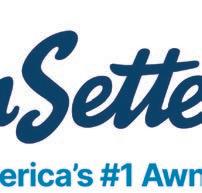















1. TELEVISION: What is the name of the bar where Homer Simpson hangs out?
2. MUSIC: What are the rst names of the Jackson 5?
3. MOVIES: What prop is found in almost every scene in “ e Fight Club”?
4. ANATOMY: What does the term “hallux” refer to in human anatomy?
5. GEOMETRY: What is the perimeter of a circle called?
6. LITERATURE: What is Ron Weasley’s patronus in the “Harry Potter” book series?
7. ANIMAL KINGDOM: How many tusks does a warthog have?
8. GEOGRAPHY: How many states does the Paci c Crest Trail cross?
9. SCIENCE: What is a common name for iron oxide?
10. U.S. PRESIDENTS: Which president was awarded the Distinguished Flying



Cross for bravery in WWII?
Answers
1. Moe’s Tavern.
2. Jackie, Tito, Jermaine, Marlon and Michael.
3. A Starbucks co ee cup.
4. e big toe.
5. Circumference.
6. Jack Russell Terrier.
7. Four.
8. ree (California, Oregon, and Washington).
9. Rust.
10. George H.W. Bush. (c) 2025 King Features Synd., Inc.




















PGA
BY MONTE WHALEY MONTE@COTLN.ORG
Dan Medina faced plenty of dire situations in his former role as a United State Navy technician who routinely rendered harmless deadly underwater explosives. us, his attempt to sink a 20-foot putt under the sun-drenched sky at Commerce City’s Bu alo Run golf course last week appeared pretty drama-free.
Medina – an Explosive Ordinance Disposal expert during his time in the Navy - did well. His ball crawled just up to the hole on the practice green at Bu alo Run, where he and other military veterans gathered for some instruction from local pros from the Professional Golf Association.
Medina appreciated the meticulous discipline and solid form needed from him to produce a nearly perfect putt. He also felt at ease and calm that only a golf course can conjure.
“During the drive here, I felt under pressure,” said the El Paso County resident. “But once I am here, I feel relaxed and ok with myself. is feels good, no doubt about it.”
It’s a feeling shared by retired Army veteran Bob Ervin, who was among
seven former service members being tutored by Bu alo Run Head PGA Pro Garrett Ho man and First Assistant PGA Pro Jordan LeBlanc.
“With these guys, I know we are getting the best teachers there are,” Ervin said. “ ere is nothing like getting tips from a real pro.”
Well-being through golf e Bu alo Run instructors and students are part of a nationwide program called PGA HOPE, or Helping Our Patriots Everywhere, a developmental six-to-eight-week curriculum taught by PGA of America golf professionals. e classes are geared toward former military members and are free to them. PGA Hope is being o ered at more than 550 program locations in the U.S., across all 50 states, impacting more than 17,000 veterans annually, according to a PGA Hope news release.
PGA HOPE is described as a rehabilitative golf program for veterans to enhance their physical, mental, social and emotional well-being. Participants of PGA HOPE programs include military veterans living with physical or cognitive challenges such as Traumatic Brain Injury (TBI), Post-Traumatic Stress Disorder (PTSD) and amputees, among other challenges, the news release states.
Led by PGA of America Golf Professionals, PGA HOPE is the only adaptive golf program that has a Memorandum
of Understanding with the Department of Veterans A airs, which enables VA Facilities to refer Veterans to the PGA HOPE program as a form of therapy.
an, recently led a group of Colorado military veterans to compete in the 2025 PGA HOPE Secretary’s Cup , held May 12th at Carmel Country Club in Charlotte, NC. e Secretary’s Cup is a spirited nine-hole golf competition that kicks o during PGA Championship week and features 12 teams of four military veterans who have participated in the PGA HOPE program, according to the news release.
ans in the tournament were Jeremiah James, Commerce City, U.S. Army; Paul Garcia, Commerce City, United States Air Force; Erich Posdzich, Commerce City, United States Marine Corps and Joshua Lee, Denver, United States Navy.
are tutored on all facets of golf, including the proper placement of feet on putts, hitting out of sand traps and driving the ball. Most have had some experience on the fairways and he hopes to teach them the best gol ng habits, he said.
cially speed control on the greens,” LeBlanc said. “We keep things, especially putting, simple. But mostly we want to teach them to enjoy the game, that’s why we are out here.”

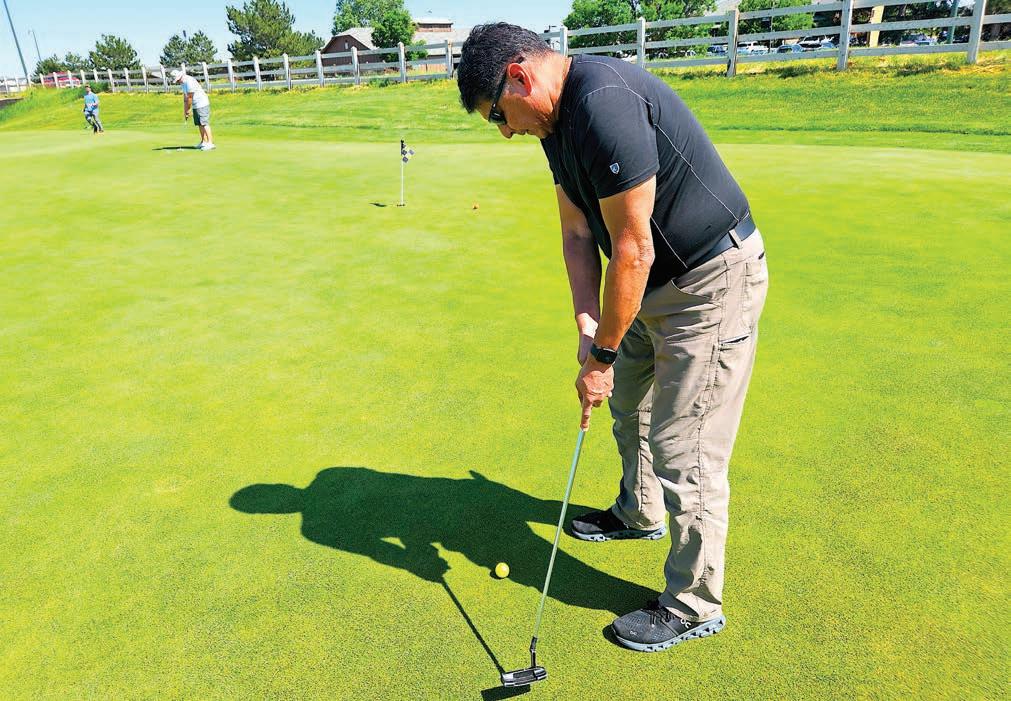

pavement.
Bids are requested for the following Contract: Clear Creek County Contract for RC 25-04 Silver Lake Bridge Repair
Obtaining the Bidding Documents Information and Bidding Documents for the Project can be found on the following designated website: https://www.clearcreekcounty.us/bids. aspx
Prospective Bidders must register as a plan holder via email to receive a copy of the plans, a link to the Prospective Bidder Submittal Folder, and invitations to meetings and bid opening: Email sstreepey@clearcreekcounty.us; subject line RC 25-04 RFB.
Prospective Bidders are urged to sign up to receive a text message or email when new Bidding Documents are periodically uploaded to the designated website such as addenda, reports, and other information relevant to submitting a Bid for the Project by clicking “Sign up” at the top of the webpage.
All official notifications, addenda, and other Bidding Documents will be offered only through the designated website and the Prospective Bidder Submittal Folder. Neither Owner nor Engineer will be responsible for Bidding Documents, including addenda, if any, obtained from sources other than the designated website or Prospective Bidder Submittal Folder.
Pre-bid
REQUEST FOR PROPOSALS FOR CHILDCARE SCHOLARSHIP PROGRAM ADMINSTRATION 405 Argentine Street Georgetown, CO 80444
DEADLINE FOR PROPOSAL
SUBMISSION: JULY 18, 2025, at 4:00 p.m
PURPOSE
Creek County is soliciting proposals from qualified entities to manage and administer a childcare scholarship program for eligible families within the County. The program administrator will be responsible for designing and managing a fair and transparent scholarship
process, tracking disbursements, and pursuing supplemental funding sources to support and expand the program.
A County Human Services staff member must be seated on the selection committee to ensure alignment with human services goals and policies.
Only applicants who meet the eligibility and selection criteria for administering scholarships may be awarded. The program manager may not award scholarships to its own organization or staff or any affiliated entity.
PROJECT DESCRIPTION Clear Creek County is launching a childcare scholarship program to help working families afford high-quality early learning opportunities for their children. The program is funded through a combination of County Lodging Tax revenue and other public funds, and is designed to directly support families by reducing out-of-pocket childcare costs.
The County seeks a qualified administrator to manage this scholarship program. The administrator will be responsible for developing a transparent application process, verifying eligibility, distributing scholarship awards directly to approved providers on behalf of families, and tracking outcomes and spending.
Additionally, the administrator is expected to actively seek other funding sources to supplement County dollars, including contributions
from participating municipalities, philanthropic organizations, or state/federal sources.
SCOPE OF SERVICES
The successful proposer will be responsible for the following activities related to the administration of a childcare scholarship program:
1. Scholarship Program Design:
• Develop a transparent and fair application process for eligible childcare providers
Establish eligibility and selection criteria with input from County staff and community stakeholders
• Ensure application, award, and compliance processes are accessible and culturally responsive
2. Selection Process & Committee Coordination
Assemble and convene a scoring committee composed of no fewer than five members, including one (1) designated representative from the Clear Creek County Human Services Department
Ensure all scoring decisions and funding recommendations are based on standardized criteria approved by the County
•Prohibit any applicant or financially interested entity from serving on the scoring panel
3. Application Solicitation and Evaluation
Publicly post a call for applications for childcare support projects
Receive, vet, and score proposals according to standardized criteria including:
1.Equity and inclusion in service delivery
2.Financial and operational feasibility
3. Alignment with Clear Creek County strategic priorities
4.Ability to deliver measurable outcomes
4. Monitoring and Reporting
• Execute subgrantee agreements (subject to County legal review)
•Monitor project performance and financial compliance
Submit mid-year and end-of-year reports to the County, including disbursement summaries, performance indicators, and qualitative feedback
Retain and make available all program records for County audit or inspection for at least three years after program closeout
The deadline for submitting a proposal is 4:00 p.m. MST, Friday, July 18, 2025.
A full copy of this Request for Proposals can be found here: https://www.clearcreekcounty.us/bids.aspx
Project Contact: Colton Rohloff crohloff@ clearcreekcounty.us 303-679-2312 Legal
The Triple Bypass - Evergreen to Avon July 12, 2025 5am-8pm (full course)
Temporary road closures: -Hwy 103 WB - 5am-10am -Hwy 103 EB 6:30am-11am -Both directions Alvarado Rd. East of Georgetown between Whitewater Park and CR308, 6am-12pm -WB Alvarado Rd. From CR308, 7am-12pm



